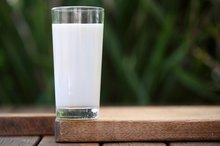What does fact checked mean?
At Healthfully, we strive to deliver objective content that is accurate and up-to-date. Our team periodically reviews articles in order to ensure content quality. The sources cited below consist of evidence from peer-reviewed journals, prominent medical organizations, academic associations, and government data.
- National Institutes of Health Office of Dietary Supplements; Vitamin D; Feb. 25, 2011
- Oregon State University Linus Pauling Institute; Vitamin D; March 2004
The information contained on this site is for informational purposes only, and should not be used as a substitute for the advice of a professional health care provider. Please check with the appropriate physician regarding health questions and concerns. Although we strive to deliver accurate and up-to-date information, no guarantee to that effect is made.
Side Effects of Vitamin D3 Capsules
Vitamin D comes in two forms and and plays a critical role in controlling calcium levels and regulating cell health and the immune system. Your body can make vitamin D from sunlight, and some foods also contain it. You can also take capsules containing the two forms of the vitamin: vitamin D2, or ergocalciferol, and vitamin D3, or cholecalciferol 3. If you buy a vitamin D supplement over the counter, it's vitamin D3.
Upper Intake Limits
Vitamin D is a fat-soluble vitamin, meaning you body stores what it does not immediately need. You cannot get too much vitamin D from the sun, but if you take over-the-counter vitamin D3 capsules you should know how much of the nutrient your body can safely accommodate. The upper intake limits for vitamin D3 depend on your age. For children and adults 9 and older, the maximum daily intake is 4,000 IUs per day, or 100 mcg. For kids between the ages of 4 and 8, the maximum daily intake is 3,000 IUs or 75 mcg. Toddlers who are 1 to 3 years old should get no more than 2,500 IUs or 63 mcg per day. For babies younger than 6 months, the established maximum intake is 1,000 IUs or 25 mcg. For babies between 7 and 12 months old, the maximum daily intake is 1,500 IUs or 38 mcg.
- Vitamin D is a fat-soluble vitamin, meaning you body stores what it does not immediately need.
- For babies between 7 and 12 months old, the maximum daily intake is 1,500 IUs or 38 mcg.
Side Effects
Are High Doses of Rose Hips Dangerous?
Learn More
People who take over-the-counter vitamin D3 supplements may experience excessive thirst, frequent urination, constipation, diarrhea, vomiting, poor appetite, weight loss, a metallic taste, bone pain, muscle problems, fatigue, itchy skin and sore eyes, the University of Maryland Medical Center reports. Side effects more commonly occur with high doses of cholecalciferol 3. Before taking vitamin D3 capsules, consult with your doctor about a safe and effective dose.
Vitamin D Toxicity
If you take high doses of vitamin D3 over an extended period, you may end up with too much of the vitamin stored in your body. This can cause potentially serious health effects. In particular, too much vitamin D can cause the level of calcium in your blood to increase, a condition called hypercalcemia. People who have hypercalcemia can experience loss of bone mass and may also develop kidney stones and calcium deposits in other organs. This high blood calcium level has been associated with massive doses of vitamin D3 in excess of 50,000 IUs per day.
- If you take high doses of vitamin D3 over an extended period, you may end up with too much of the vitamin stored in your body.
Safety Precautions
Can Too Much Calcium Carbonate Have Side Effects?
Learn More
Because vitamin D3 capsules can affect calcium levels in the body, people with certain conditions should not take them. If you already have a high calcium level because of another health condition, do not take vitamin D3 your doctor advises you to do so. The vitamin also may not be safe for people who have high phosphorus levels and those with heart and kidney disease, the University of Maryland Medical Center reports.
- Because vitamin D3 capsules can affect calcium levels in the body, people with certain conditions should not take them.
- The vitamin also may not be safe for people who have high phosphorus levels and those with heart and kidney disease, the University of Maryland Medical Center reports.
Related Articles
References
- National Institutes of Health Office of Dietary Supplements; Vitamin D; Feb. 25, 2011
- Oregon State University Linus Pauling Institute; Vitamin D; March 2004
- Drugs.com: Cholecalciferol
- Holick MF, Gordon CM. Patient Guide to Vitamin D Deficiency. The Journal of Clinical Endocrinology & Metabolism. 2011;96(7):1-2. doi:10.1210/jcem.96.7.zeg33a
- Sunyecz JA. The use of calcium and vitamin D in the management of osteoporosis. Ther Clin Risk Manag. 2008;4(4):827-836. doi:10.2147/tcrm.s3552
- Giovannucci E, Liu Y, Hollis BW, Rimm EB. 25-hydroxyvitamin D and risk of myocardial infarction in men: a prospective study. Arch Intern Med. 2008;168(11):1174-1180. doi:10.1001/archinte.168.11.1174
- Gorham ED, Garland CF, Garland FC, et al. Optimal vitamin D status for colorectal cancer prevention: a quantitative meta analysis. Am J Prev Med. 2007;32(3):210-216. doi:10.1016/j.amepre.2006.11.004
- Lappe JM, Travers-Gustafson D, Davies KM, Recker RR, Heaney RP. Vitamin D and calcium supplementation reduces cancer risk: results of a randomized trial. The American Journal of Clinical Nutrition. 2007;85(6):1586-1591. doi:10.1093/ajcn/85.6.1586
- Prentice RL, Pettinger MB, Jackson RD, et al. Health risks and benefits from calcium and vitamin D supplementation: Women’s Health Initiative clinical trial and cohort study. Osteoporos Int. 2013;24(2):567-580. doi:10.1007/s00198-012-2224-2
- Urashima M, Segawa T, Okazaki M, Kurihara M, Wada Y, Ida H. Randomized trial of vitamin D supplementation to prevent seasonal influenza A in schoolchildren. Am J Clin Nutr. 2010;91(5):1255-1260. doi:10.3945/ajcn.2009.29094
- Salehpour A, Hosseinpanah F, Shidfar F, et al. A 12-week double-blind randomized clinical trial of vitamin D₃ supplementation on body fat mass in healthy overweight and obese women. Nutr J. 2012;11:78. doi:10.1186/1475-2891-11-78
- Carrillo AE, Flynn MG, Pinkston C, et al. Impact of vitamin D supplementation during a resistance training intervention on body composition, muscle function, and glucose tolerance in overweight and obese adults. Clin Nutr. 2013;32(3):375-381. doi:10.1016/j.clnu.2012.08.014
- Marcinowska-Suchowierska E, Kupisz-Urbańska M, Łukaszkiewicz J, Płudowski P, Jones G. Vitamin D Toxicity-A Clinical Perspective. Front Endocrinol. 2018;9:550. doi:10.3389/fendo.2018.00550
- Ross AC, Manson JE, Abrams SA, et al. The 2011 report on dietary reference intakes for calcium and vitamin D from the Institute of Medicine: what clinicians need to know. J Clin Endocrinol Metab. 2011;96(1):53-58. doi:10.1210/jc.2010-2704
- Bouillon R, Van Schoor NM, Gielen E, et al. Optimal vitamin D status: a critical analysis on the basis of evidence-based medicine. J Clin Endocrinol Metab. 2013;98(8):E1283-E1304. doi:10.1210/jc.2013-1195
- American Academy of Dermatology. Position Statement of Vitamin D. 2010.
- Taksler GB, Cutler DM, Giovannucci E, Keating NL. Vitamin D deficiency in minority populations. Public Health Nutr. 2015;18(3):379-391. doi:10.1017/S1368980014000457
- Holick MF, Binkley NC, Bischoff-Ferrari HA, et al. Evaluation, treatment, and prevention of vitamin D deficiency: an Endocrine Society clinical practice guideline. J Clin Endocrinol Metab. 2011;96(7):1911-1930. doi:10.1210/jc.2011-0385
- Cannell JJ, Vieth R, Umhau JC, et al. Epidemic Influenza and Vitamin D. Epidemiol Infect. 2006; 134:1129-40.
- Carrillo AE1, Flynn MG, Pinkston C, Markofski MM, Jiang Y, Donkin SS, Teegarden D. Impact of Vitamin D Supplementation During a Resistance Training Intervention on Body Composition, Muscle Function, and Glucose Tolerance in Overweight and Obese Adults. Clin Nutr. 2013 Jun;32(3):375-81. doi: 10.1016/j.clnu.2012.08.014. Epub 2012 Aug 31.
- Ginde AA, Mansbach JM, Camargo CA, Jr. Association Between Serum 25-Hydroxyvitamin D Level and Upper Respiratory Tract Infection in the Third National Health and Nutrition Examination Survey. Arch Intern Med. 2009; 169:384-90.
- Giovannucci E, Liu Y, Hollis BW, Rimm EB. 25-hydroxyvitamin D and Risk of Myocardial Infarction in Men: a Prospective Study. Arch Intern Med. 2008; 168:1174-80.
- Gorham ED, Garland CF, Garland FC, Grant WB, Mohr SB, Lipkin M, Newmark HL, Giovannucci E, Wei M, Holick MF. Optimal Vitamin D Status for Colorectal Cancer Prevention: a Quantitative Meta-analysis. Am J Prev Med. 2007 Mar;32(3):210-6.
- Heaney, Robert P. “The Vitamin D Requirement in Health and Disease.” The Journal of Steroid Biochemistry & Molecular Biology 97 (2005):13-9.
- Holick MF. Vitamin D. In: Shils M, Olson J, Shike M, Ross AC, ed. Modern Nutrition in Health and Disease, 9th ed. Baltimore: Williams and Wilkins, 1999.
- National Institutes of Health Office of Dietary Supplements. Vitamin D: Dietary Supplement Fact Sheet. University of Ottawa Evidence-based Practice Center. Effectiveness and Safety of Vitamin D in Relation to Bone Health. Agency for Healthcare Research and Quality. Aug 2007: 07-E013.
- Salehpour A1, Hosseinpanah F, Shidfar F, Vafa M, Razaghi M, Dehghani S, Hoshiarrad A, Gohari M. A 12-week Double-blind Randomized Clinical Trial of Vitamin D₃ Supplementation on Body Fat Mass in Healthy Overweight and Obese Women. Nutr J. 2012 Sep 22;11:78. doi: 10.1186/1475-2891-11-78.
- Urashima M, Segawa T, Okazaki M, Kurihara M, Wada Y, Ida H. Randomized Trial of Vitamin D Supplementation to Prevent Seasonal Influenza A in Schoolchildren. Am J Clin Nutr. 2010 91:1255-60. Epub 2010 Mar 10.
- Wilkins, Consuelo H. and Yvette I. Sheline, et al. “Vitamin D Deficiency Is Associated with Low Mood and Worse Cognitive Performance in Older Adults.” American Journal of Geriatric Psychiatry 14 (2006): 1032-40.
Writer Bio
Anna Aronson began working as a journalist in 2000 and spent six years at suburban Chicago newspapers before pursuing freelance work. She enjoys writing about health care topics, in particular obstetrics, pediatrics and nutrition. She received a Bachelor of Arts in journalism from Eastern Illinois University and is now studying for a Master of Science in medicine degree to become a physician's assistant.









